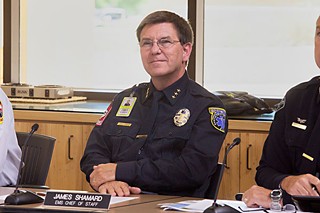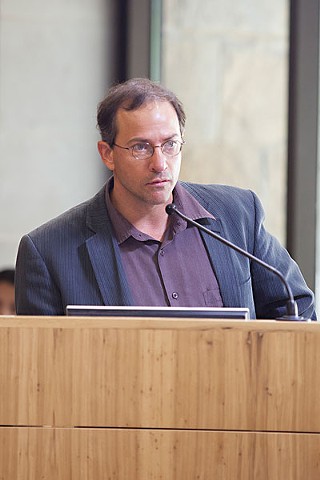Life Support
The complicated system that is the Austin-Travis Co. EMS is nationally recognized for saving lives. As Austin continues to grow, can the system save itself?
By Jordan Smith, Fri., Aug. 16, 2013
(Page 3 of 3)
County officials have said repeatedly that they have no intention of fracturing the service. "I don't see the county wanting to do that," says retiring County Judge Sam Biscoe. At issue in large part, however, is how the system is paid for – and how Austin's EMS officials have previously responded to county concerns about service. For example, he says, at present the county still pays the EMS tab for residents of cities in the county that used to be small – like Lakeway and Pflugerville – but that have grown significantly, and should be paying for at least some of the services they receive. And since the vast majority of Travis County residents are also residents of the city of Austin, the county has the duty to look at ways to offset the burden of double taxation, he said.
Eckhardt, who sat on the Court's emergency services committee, said she believes that exploring the possibility of consolidating the 14 ESDs is an important step to strengthening a countywide approach to providing emergency services. Although they're independent taxing agencies that can't be compelled to surrender autonomy to the county for consolidation, Eckhardt says county and ESD officials have been working together for years to build a level of trust that might allow some level of consolidation to happen. Consolidation would also ensure that emergencies countywide are tended to by the very first responders available, regardless what slice of the county they're "assigned" to. That in turn could be enhanced by the advanced life-support care provided both by ATCEMS and STAR Flight.
At the time of this writing, only ESD 11 Chief Bailey has come out publicly in favor not only of consolidating the ESDs, but also of pulling out of ATCEMS and instead creating a countywide fire-based EMS service, which he says will save the county money. The county wouldn't have to hire inexperienced paramedics or even train firefighters as medics, he said, to offer the advanced-level EMS service. Instead, he says, the county could offer county jobs to current city employees. "My guess is that if I can pay you the same amount and you're not going to get your teeth kicked in [on a busy and tiring shift] Downtown, I'm thinking there'll be people who are interested," says Bailey. "So why wouldn't we go in that direction?"
There may be at least one reason that this isn't doable at present: To date, Hinchey has declined to allow under his license paramedics who would work exclusively out of the county stations. Clinically, the thinking is that advanced-level paramedic skills must be regularly honed to keep them sharp. As it stands, there are not enough advanced-level calls in small villages, cities, and unincorporated areas of the county to do that, Hinchey and others say.
To Eckhardt, that makes sense. "It's better to have a consolidated system in a high-volume area," as ATCEMS essentially operates its paramedics, concentrated in the city of Austin, she said. "That makes a lot of clinical sense." But the "downside of that, from a countywide fire perspective, is that if your [paramedic] system is designed specifically for an urbanized setting, and then you try to scale that countywide" – as Marquardt and others would like to see happen – "it's going to be extremely expensive."
That raises the question of whether city EMS officials have really been listening to what the county says it needs: the ability to respond quickly to emergencies with high-quality paramedic service. Bailey says those dual needs haven't always been heard; for example, there is just one ambulance stationed in his large district and it's right on the city-county line, and thus spends a good amount of time running calls in the city. That means that even when his crews are quick to a scene, patients in need of transport to a hospital are going to be waiting around a while – and that is a dicey situation, considering that the nature of an emergency is impossible to predict. He charges that ATCEMS has been more concerned about stationing ambulances where they can easily move into the city to cover calls – often leaving his ESD without coverage. If there were a countywide, fire-based EMS system, employees could be cross-trained and, importantly, there'd be no waiting for transport service in critical, time-sensitive emergencies. Marquardt agrees that the county for years has been asking ATCEMS to do more with fewer resources than it needs, indirectly putting patients at risk. "That's a pattern we've had with Travis County," he says. "Then we get increased response times and we have to run more and more, including from the city, to make up for the lack of resources in the county."
County officials, including Biscoe and Hobby, say these are valid concerns, and are among the reasons the county needs to determine exactly how many ambulances and paramedics it needs, how to best use STAR Flight, and exactly where its resources should be located. And after years when city and county essentially didn't communicate at all on these issues, this year the two governments are finally coming together in the EMS system's best example of intergovernmental cooperation to date.
The outcome, however, remains in doubt.
Zones of Collaboration
In order to best determine where resources are needed, not only in the county but throughout the ATCEMS system, Hobby and Rodriguez, along with ATCEMS Chief of Staff James Shamard, early this year formed a "Zone Group," which amassed statistics for every ambulance in every "zone" of the city and county and determined, to the granular level – down to every hour of every day of the week – where calls are happening, where resources are stationed, and how resources shift when a call comes in, all in an effort to figure out how response times and resource redundancy can work together to promote an optimal system. The project has resulted in reams of data – charts and maps and lists designed to reveal not only where resources are used, but where they may be needed in the future.
Both county and city officials are pleased with the group's accomplishments. "I've been with the city and EMS for about 17 years and I think ... the relationship and how we're working together and ... the product that we're creating is like nothing we've ever done before," Shamard told Commissioners in May. "I think we're really tackling the real issues, which is how we get the most appropriate service to the sickest patients [in] the appropriate time based on the financial constraints we have to work with."
The new cooperation between entities has also prompted officials to reconsider how the EMS budget is apportioned, and for the first time, in fiscal year 2014, the county will be paying into the system based on "a cost determination model," says Hobby – in other words, paying only for what it uses and not a simple percentage of the agency's entire budget, which last year was $55.6 million, with $12.5 million of that billed to the county.
The changes, Hobby said, have been a long time coming. Back when the county agreed to fund a percentage of the service, the thinking was that doing it that way would make the county "part of the budget, thinking that if we were part of the budget then we would be treated as part of a system. We never felt like that happened," he said. But with the work he and Rodriguez have been doing, "you're seeing the city and county working more closely together," he said. "For the first time – and I think they're delighted, as we're delighted – that we ... both know what the cost is on both sides."
While Rodriguez, Hobby, and Shamard seem pleased about the work at hand, Marquardt has remained skeptical. All spring – seemingly, at every public meeting where EMS issues are discussed – the union president expressed concerned about the county's motives, and warned that Hobby was endangering county residents by withholding promised funds that would immediately add paramedic resources to the county – including a new ambulance stationed in East Travis County.
The roughly $1.5 million to provide the ambulance (located within ESD 4, which has been broken by Austin's annexation into disconnected islands that ring the city from east to west along its northern border) were included in the county's FY 13 budget, but were never actually allocated until this summer. (The new ambulance finally came into service July 1.) Throughout the spring, Marquardt charged that Hobby was purposely withholding the funds, undermining ATCEMS cohesion – and offering another sign that the county perhaps wants to secede. "They're rebelling against putting any more ATCEMS units" in the county, he said.
Hobby has maintained that the decision to delay the ambulance was related directly to the ongoing zone work; Marquardt says Hobby is simply using that as a front for another agenda. (Frustrated with Marquardt's dogged, public harping on the issue, Hobby momentarily lost his cool during the May Commissioners meeting: "Tony, I can explain it to you, but I can't understand it for you," he said.)
The uneasiness about the future of the ATCEMS system is not surprising. How the city and county are cooperating – and whether they'll continue to do so going forward, into the next four decades of local EMS service – is an overarching issue that in many ways overshadows a world of small hurts and worries below. Does ATCEMS have a good recruiting system? Does it take too long to clear paramedics for duty, leaving a string of ever-growing vacancies? (As of June 1, the department reported 40 total vacancies out of a total staff of 457.) Does focusing on the relatively small proportion of cardiac arrests, no matter how critical, really provide meaningful data about the health of the system? Does the switch to staffing ambulances with one paramedic and one intermediate or basic EMT (from two paramedic staffing) place patients in danger? Is Rodriguez a strong enough leader to get the agency through this protracted rough patch?
On this last point, city Public Safety Commissioner Mike Levy, who has long been passionate about local EMS, does not mince words: "Culture, vision, and values start at the top, and trickle down," he wrote in an email. "Rodriguez is rarely seen outside his office. ... Just a lump. Which would be OK, but we're talking about the degree to which the program can make a difference in people's lives." In particular, Levy has been vocally opposed to the switch to paramedic/EMT staffing, which he believes puts patients in jeopardy and is designed to hide the agency's inability to recruit trained paramedics to an agency in peril.
Deputy City Manager McDonald strongly disagrees. Rodriguez has had a "difficult set of circumstances to manage" and because he has to answer not only to the city but also has to be responsive to the county, not every challenge the agency faces "is in his purview." And he disagrees with the concerns Levy expresses about the ambulance staffing – paramedic/EMT staffing has been in place for years in agencies across the country. At the end of the day, McDonald says, the city remains committed to building on what ATCEMS has to create a smart and cohesive regional system.
To Hinchey, the stress over the staffing change, for example, is natural for those involved in a system that is changing and will continue to change over the next few years – as a result not only of internal pressures, but also in response to the fast-changing world of health care delivery of which EMS is a part. While responding to emergencies will always be at the core of any EMS system, health care reform that places a premium on keeping people out of hospitals and healthy in their communities is necessarily reshaping the industry.
That understanding is driving a lot of innovation at ATCEMS, says Hinchey. He started a citywide CPR instruction program that aims to educate at least 500,000 residents in compression-only CPR in order to help boost rates of bystander CPR – and thus increase cardiac survival rates. The system has instituted a nationally recognized community paramedicine program that seeks to reduce reliance on 911 and EMS by individuals who use emergency rooms as their source of health care – not uncommon in Texas, where fully 25% of the population lacks health insurance. The program connects residents in need with paramedics who can help them to access appropriate community services.
ATCEMS is evolving, not only in how it handles emergencies, but also to how it fits into the broader system of public health. In short, says Hinchey, although EMS systems have been around for some 40 years now, they're still relatively young agencies that for the first time are being asked to re-evaluate how they do what they do and what that will look like in the future. "I think it is a difficult time for changes in the county, changes in the city; there's a lot of pressure in different places and it's basically about change – this is a system in evolution, adapting to a changing world," he said. "My goal is that Austin's is a system that changes and evolves and meets the needs of the community in a better way than we've done in the past," he continued. "But we've got to be OK with smashing the good china to move on."
Got something to say on the subject? Send a letter to the editor.












